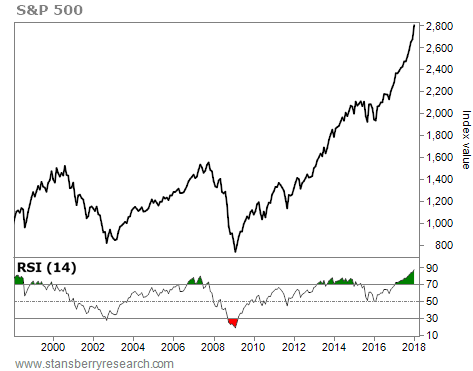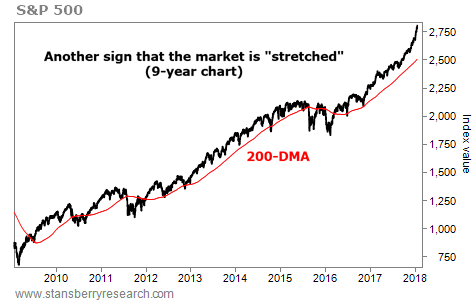| Home | About Us | Resources | Archive | Free Reports | Market Window |
|
The Weekend Edition is pulled from the daily Stansberry Digest. The Digest comes free with a subscription to any of our premium products.
The Warning Signs Are Mounting... A Correction Is InevitableBy
Saturday, January 20, 2018
The large-cap S&P 500 Index and small-cap Russell 2000 Index burst out of the gates to new highs to start 2018. In the first week of the new year, the Dow Jones Industrial Average broke 25,000 for the first time ever, less than a month after hitting 24,000.
That was the fastest 1,000-point move for the Dow in history. But it didn't last long... The index surged to more than 26,000 this week – seven trading days after it hit 25,000.
And it's not just in the U.S... Stocks around the world are soaring, too.
Germany's DAX Index is trading close to record levels, while Japan's Nikkei 225 Index recently hit its highest level since 1991. Even Russia and emerging markets like China, South Korea, and Taiwan are seeing massive breakouts in their stock markets.
They can't sprint all-out for miles on end. They need to take a "breather" occasionally. And right now, we're seeing signs that the market needs to catch its breath...
First, we look at the relative strength index (or "RSI") of the S&P 500. The RSI is a trusted momentum indicator, with values ranging from zero to 100.
When an asset quickly falls, it can enter "oversold" territory with an RSI below 30. This signals that the asset may be due for a rally. But the opposite is true, too. When an asset rises faster than normal, it can become "overbought," with an RSI above 70. This is usually a time for caution... and a signal that a correction may be around the corner.
Today, the S&P 500's monthly RSI is sitting above 80. As you can see in the following chart, it hasn't been this high since the dot-com bubble of the late 1990s...
 This metric is considered a rough gauge of the market's long-term trend.
During bull markets, stocks tend to spend most of their time above the 200-DMA. During bear markets, they spend most of their time below it. And perhaps most important, stocks rarely stray too far from this line in either direction before returning to it.
The following chart of the S&P 500 shows how it works.
As you can see, since stocks moved back above this trendline following the financial crisis in 2009, they have rarely traded below it.
You'll also notice that whenever stocks have rallied significantly above this line, they have eventually come back to "test" it – touching it, or even moving below it briefly – before continuing higher...
 Right now, the S&P 500 is more than 10% above the 200-DMA. And it hasn't tested it in more than a year. This is unusual... In fact, the market has only been this stretched above the 200-DMA three other times since the bull market began. And each of those cases preceded a sharp correction over the next several months.
Its monthly Asset Allocation Survey shows how individual investors are currently positioned across stocks, bonds, and cash.
December's reading showed that investors are now holding 72% of their portfolios in stocks. This is the highest allocation since the dot-com bubble. And it's three percentage points higher than November's reading – the biggest one-month jump in four years.
In short, investors are suddenly pouring more money into stocks than they have in nearly two decades.
As Steve Sjuggerud has explained, several other indicators continue to give the "green light" today. This suggests the next market decline is likely to be a buying opportunity in the ongoing "Melt Up," rather than the start of a true bear market.
More important, as Stansberry Research founder Porter Stansberry noted in the January 12 Digest, even if he's correct and a bear market is approaching, selling your stocks now could be a terrible mistake...
If you're looking for more help preparing your portfolio, be sure to join us Wednesday night for a special discussion about our Stansberry Portfolio Solutions product. The presentation will begin promptly at 8 p.m. Eastern time.
We launched this product last February to take all the guesswork out of creating and managing a "bulletproof" portfolio. The results and feedback from last year's members have been even better than we could've hoped... And we'll be opening these portfolios to new members for a short time soon.
This event is absolutely free to attend. Click here to learn more and reserve your spot now.
Regards,
Justin Brill
Editor's note: On Wednesday at 8 p.m. Eastern time, Porter will team up with Dr. Steve Sjuggerud and Dr. David Eifrig to host a special free event. In it, they'll reveal their 2018 market predictions... explain what you should do if you're nervous about a correction... show you a "bulletproof" portfolio... and much, much more. Reserve your spot right here.
|
Recent Articles
|

